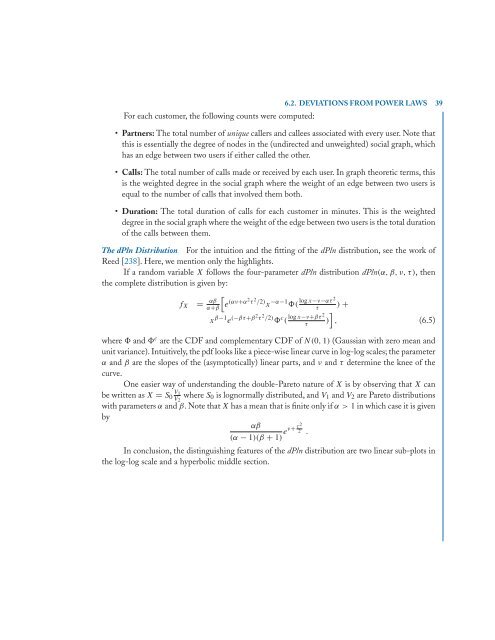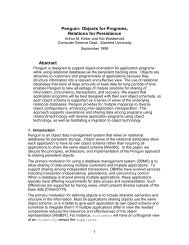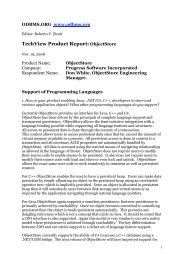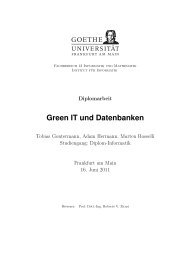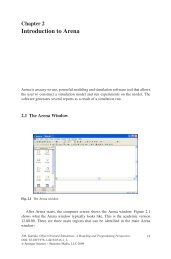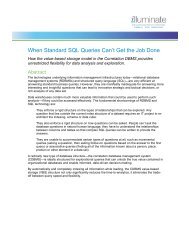Download Chapters 3-6 (.PDF) - ODBMS
Download Chapters 3-6 (.PDF) - ODBMS
Download Chapters 3-6 (.PDF) - ODBMS
Create successful ePaper yourself
Turn your PDF publications into a flip-book with our unique Google optimized e-Paper software.
For each customer, the following counts were computed:<br />
6.2. DEVIATIONS FROM POWER LAWS 39<br />
Partners: The total number of unique callers and callees associated with every user. Note that<br />
this is essentially the degree of nodes in the (undirected and unweighted) social graph, which<br />
has an edge between two users if either called the other.<br />
Calls: The total number of calls made or received by each user. In graph theoretic terms, this<br />
is the weighted degree in the social graph where the weight of an edge between two users is<br />
equal to the number of calls that involved them both.<br />
Duration: The total duration of calls for each customer in minutes. This is the weighted<br />
degree in the social graph where the weight of the edge between two users is the total duration<br />
of the calls between them.<br />
The dPln Distribution For the intuition and the fitting of the dPln distribution, see the work of<br />
Reed [238]. Here, we mention only the highlights.<br />
If a random variable X follows the four-parameter dPln distribution dPln(α, β, ν, τ), then<br />
the complete distribution is given by:<br />
<br />
fX = αβ<br />
α+β e (αν+α2τ 2 /2) x−α−1 log x−ν−ατ<br />
( 2<br />
τ<br />
xβ−1e (−βτ+β2τ 2 /2) c log x−ν+βτ<br />
( 2 <br />
τ )<br />
) +<br />
, (6.5)<br />
where and c are the CDF and complementary CDF of N(0, 1) (Gaussian with zero mean and<br />
unit variance). Intuitively, the pdf looks like a piece-wise linear curve in log-log scales; the parameter<br />
α and β are the slopes of the (asymptotically) linear parts, and ν and τ determine the knee of the<br />
curve.<br />
One easier way of understanding the double-Pareto nature of X is by observing that X can<br />
be written as X = S0 V1<br />
V2 where S0 is lognormally distributed, and V1 and V2 are Pareto distributions<br />
with parameters α and β. Note that X has a mean that is finite only if α>1 in which case it is given<br />
by<br />
αβ<br />
τ2<br />
eν+ 2 .<br />
(α − 1)(β + 1)<br />
In conclusion, the distinguishing features of the dPln distribution are two linear sub-plots in<br />
the log-log scale and a hyperbolic middle section.


